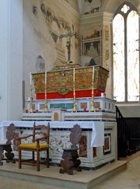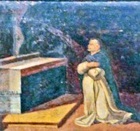
Blessed James Bianconi praying before a Crucifix
in San Giorgio (later SS Domenico e Giacomo) that sprays him with blood
Detail from the sarcophagus (1589) in the Pinacoteca
Blessed James Bianconi (1220-1301) was born in Bevagna and was received into the Dominican Order at Spoleto in 1236. After his ordination, he devoted his energies to the eradication of the heresy of the Nicolaites from Umbria, and finally succeeded in converting its chief propagator, Ortinellus. He became Provincial Minister in 1281 and was elected Prior of the Dominican convents in Spoleto, in 1291 and Foligno, in 1299.
Blessed James was prominent in providing aid to refugees from Bevagna after the Emperor Frederick II sacked the city in 1249. He was subsequently active in the rebuilding of the town, which culminated in the rebuilding of Palazzo dei Consoli in 1270. In 1291, he received permission to rebuild the church of San Giorgio in Bevagna and to construct the adjoining convent. He also established two nunneries in Bevagna: Santa Lucia and Santa Margherita. Towards the end of his life, he also served as Lector at San Domenico, Orvieto, where he acted as the spiritual advisor of the Blessed Jane.
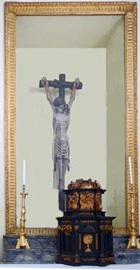
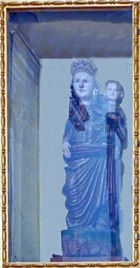
These two statues, which are thought to have been bought by the Blessed James Bianconi in Perugia, were moved from in SS Domenico e Giacomo to the Pinacoteca in 2016:
-
✴a figure of the Madonna and Child; and
-
✴a wooden Crucifix. Once, as he prayed before it because he was experiencing doubts about his salvation, blood spurted from the image and he heard Christ saying: “This blood is the sign of your salvation”.
Both statutes were recorded in the 17th century the Cappella del Crocifisso at SS Domenico e Giacomo, which belonged to the Antici family.
After a life of extraordinary austerity, James died in Bevagna. SS George and Dominic appeared to him as he died, in order to reward him for the honour that he had shown to them during his life.
Cult of Blessed James Bianconi

When the Blessed James died in 1301, he was buried in San Giorgio. Miracles were reported at his grave, and his relics were translated in 1302 into a sarcophagus that is now on the counter-facade of SS Domenico e Giacomo, to the left of the entrance.
The Dominicans rebuilt San Giorgio in 1397 and re-dedicated it as SS Domenico e Giacomo, probably as part of a bid for the canonisation of James Bianconi. Pope Boniface IX granted indulgences to those who prayed before his relics during the first three days of May. (This may have been part of a programme to secure allegiance to the Roman obedience during the papal schism. Boniface IX granted similar indulgences in respect of Blessed Peter Crisci of Foligno.) However, any early attempt to secure canonisation failed.
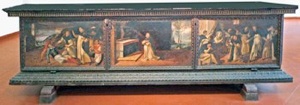
The relics were re-interred in 1589 in a new sarcophagus, as part of a fresh attempt to secure his beatification. This was adorned with painted scenes by Ascensidonio Spacca, il Fantino that depict the Blessed James:
-
✴resuscitating the mason Maurizio who had fallen from the campanile of the church (originally dedicated as San Giorgio);
-
✴praying before the Crucifix in the church that sprays him with blood; and
-
✴turning water from the fountain in the adjacent cloister into wine.
This sarcophagus is now in the Pinacoteca.
Bishop Alfonso Visconti initiated a process for canonisation in 1608, but this was halted when he died soon after. Bishop Maffeo Barberini (later Pope Urban VIII) re-opened the case in 1612, and this led in 1632 to a formal process under three bishops, including Bishop Lorenzo Castrucci of Spoleto. (The Commune paid Andrea Camasssei for three altarpieces for SS Domenico e Giacomo in 1632, when the process for his canonisation was revived, but these have not survived). This process was inconclusive, and a second was needed before Urban VIII beatified the Blessed James in 1641. The frescoes in the cloister of the convent, which depict scenes from the life of the Blessed James, commemorate this event.
